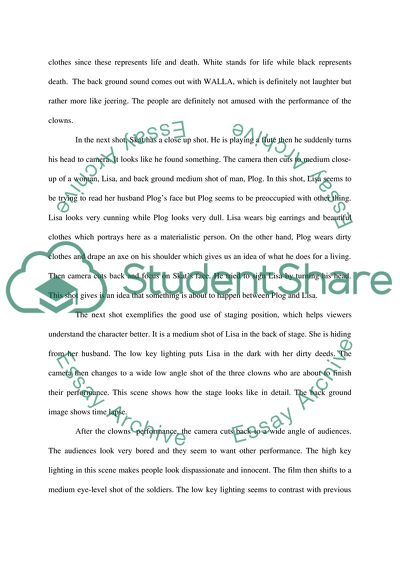
- Home
- Free Samples
- Premium Essays
- Editing Services
- Extra Tools
- Essay Writing Help
- About Us
- Studentshare
- Subjects
- Visual Arts & Film Studies
- The Seventh Seal by Ingmar Bergman
The Seventh Seal by Ingmar Bergman - Movie Review Example

- Subject: Visual Arts & Film Studies
- Type: Movie Review
- Level: Undergraduate
- Pages: 6 (1500 words)
- Downloads: 1
- Author: ngutmann
Extract of sample "The Seventh Seal by Ingmar Bergman"
He looks angry but he controls his anger and goes backstage. From this scene, the viewers can recognize Skat’s personality easily. He seems to understand his role in society, thus, he conforms to what society wants him to be. At this point, the background sound, WALLA, is filled with mockery. The audience seems to have more fun mocking and humiliating the clowns rather than enjoying their performance. As the camera zooms in on Skat while he makes his way backstage, we can see in his eyes that he is not happy with the situation.
In the next shot, the low-angle camera follows Jof and Mia as they sing and play musical instruments. Jof is supposed to know how to play his instrument which looks like a guitar, but his hands do not synchronize with the instrument’s sound. This scene can be a fly in the ointment of this film. Jof and Mia’s song seems to imply a raging epidemic of bubonic plaque.The camera then cuts to a low-angle shot of Skat in the coach. He looks into a mirror and wipes his face with a towel. While looking at the mirror, he noticed Liza in the background.
At this point, Skat’s pent-up emotions finally erupted. The scene cuts to a wide shot of Lisa sitting on the ground. Her voluptuous figure and seductive smile look inviting. A burst of natural lighting helps Lisa look more attractive. Then, Skat approaches her and they whisper to each other. While Skat and Liza committed adultery, Jof and Mia’s satirical song serves as background music. The lyric of this song seems to mock Skat and Lisa’s sinful act.The camera turns to a wide shot of Jof and Mia who are singing on stage.
The two of them look as if they are enjoying their performance. In the same scene, they take a step forward; as a result, a shot is automatically changed to a medium shot. The angle from which is shot is taken took advantage of the depth of the field to make it appear that the people are still at the right angle even if they are moving.While Jof and Mia are singing, a sound of people singing a hymn intrudes into their performance. Jof and Mia froze simultaneously and their face takes on a set expression.
The camera zooms in on Jof and Mia’s face. In this scene, their facial expressions clearly express fear at the sight in front of them. The background music makes this scene take on a heavy atmosphere, and the light which shines directly in front of the characters makes them look more terrified.The film then shifts to a medium, low-level shot of the procession. With the penitents singing a hymn, this scene takes on a dismal atmosphere. All of the penitents entered the village with tottering steps which shows that they have been through some difficult times.
The priests accompanying the procession wear clothes that look exactly like the clothes of the angel of death. The priests walk into the village with burning incenses. The smoke makes them appear as if they are gloomy angels of death. After the priests pass through the village, the penitents walk into the scene. They all seem to be either afflicted with the plague, blind, or deaf. This scene tries to depict the priests as angels of death that come for people who are already near death. The penitents’ facial expressions are gloomy and set which shows that they are getting ready as death approaches.
Some penitents whip their body in order to repent. Unlike the previous scenes with the clowns which show merriment, this scene represents death.The camera then changes to a close shot of the knight, Block, his squire, Jons, and a young girl named Tyan. The camera takes them from a straight angle so they appear to be side by side. By taking advantage of the depth of the field, this shot successfully focused on the characters and capture their facial expressions while they gaze at the procession of penitents.
Their bland and disinterested expressions give us the idea that they do not actually care about procession.
Read MoreCHECK THESE SAMPLES OF The Seventh Seal by Ingmar Bergman
History: The Magic Flute (Bergman Version, 1975)
How Movies Portray Identity and National Past
Thematic and Stylistic Consistencies
Sir Gawain and the Green Knight
Robert Bressons The Trial of Joan of Arc to Ingmar Bergmans Seventh Seal
The Seventh Seal: Philosophical Discourse
Ingmar Bergman and Auteur Theory
Italian Neorealism

- TERMS & CONDITIONS
- PRIVACY POLICY
- COOKIES POLICY